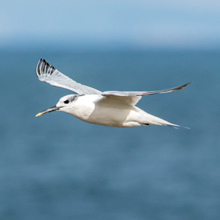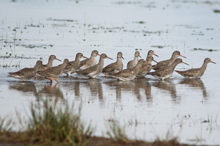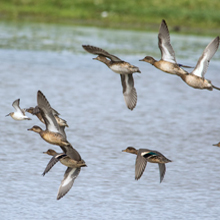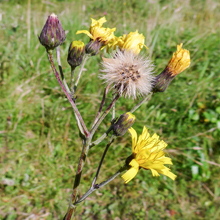|
25th September
Port
Seton, Musselburgh
The
weather edged us east again this week where it was due some sunny
spells for a while, which was a better prospect than going west into a
cold front. Breakfast at Morrison's in Dalkeith was another 9.5/10 - a
good start to the trip! Social media had
reports of
flocks of Sandwich
Terns on the shores of Port Seton and the tide was incoming so we
headed there first. The light was very good when we arrived and ' lit '
the iridescent plumage of a singing Starling perched on a lamp by the
car park. The rocks were quite busy. Bar-tailed Godwits, Curlew,
Cormorant juveniles and Redshanks were feeding and roosting close by. I
spotted a young Ringed Plover darting between rock pools as a Cormorant
flew in along with around 30 Sandwich
Terns, returning to rest after feeding. Next it was off to Musselburgh
Scrapes. There we were met by a very busy panorama with all the usual
suspects - Mallard, Redshank, Teal, Dunlin, Godwits, Tern, Curlew,
Greylags and at least 400 Oystercatchers were roosting. I managed a
nice shot of a female Teal as it fed by the waters edge.We moved to the
sea wall hoping for a wee surprise but the sea was empty. However, if
you wait a few minutes at the sea wall in Musselburgh, you're sure to
get something. Sure enough, five or six adult Gannets and three or four
juveniles began fishing 100 metres or so ahead of us. I never tire of
watching these birds diving for food. We spent around 40 minutes
watching the dramatic display. It was interesting to observe the
juveniles were hunting in a separate group from the adults. Their
diving techniques were obviously still developing. They had shorter
dives, stayed on the surface for longer and rose only a few feet before
diving again. We started off west towards the mouth of the Esk. As we
walked I managed some nice shots of Widgeon, Merganser, Goosander and
Mallard flying in to land on the Esk. The Eskmouth was very busy with
90+ Mute Swans feeding close to the sea wall. The light was fading as
rain moved in from the west so we walked back to the car for our tea.
On the way we spotted a small flock of Reed Buntings feeding,
unusually, on the rocks just below the sea wall. A nice Carrion Crow
grabbed the last of the light before we headed over to the car park. A
very productive trip indeed, finished off of course with another
'Toffee Apple Sauce' Danish pastry!
| Starling |
Bar - tailed
Godwit |
Juvenile
Cormorant |
 |
 |
 |
| Cormorant |
Curlew |
Redshank |
 |
 |
 |
| Ringed Plover |
Sandwich Tern |
Dunlin |
 |
 |
 |
| Magpie |
Teal |
Gannet |
 |
 |
 |
| Juvenile
Gannet |
Curlew |
Goosander |
 |
 |
 |
| Red - breasted
Merganser |
Mallard |
Widgeon |
 |
 |
 |
| Mute Swan |
Reed Bunting |
Carrion Crow |
 |
 |
 |
18th
September 2016
Tyninghame
Bay
It
was off east again this weekend where the weather looked to be
brightest. Breakfast at Dalkeith Morrison’s again was a 9.5
as usual.
There was not much on social media, so we decided to head for Tyningham
Bay
and see what was showing. We planned a cracking circular walk. From the
car park we'd skirt the edge of the forest till the West edge of the
salt marsh, cut across and make our way to the seafront, return back
along the beach and then back across the marsh to the car. The
toilet block at the car park gave me my first two shots - a very loud
Robin and a rather light coloured Pied Wagtail. We met a fellow
photographer setting up a shot of a Fox Moth caterpillar. A few minutes
later, we found our own Fox Moth caterpillar and a few Common Darters
on the path. As we approached the mouth of the Tyne
we hunkered down at a spot I knew was always busy with birds. Sure
enough about 6 Pied Wagtails were feeding around the many rock pools.
They were quite far away and good shots were few and far between. The
mouth of the Tyne
was rather deserted, not helped by an inconsiderate photographer
walking along the water line spooking everything in sight. We cut
across some marshy ground and made our way through the sand dunes to
the beach. The dunes proved to be rather productive with a new bug,
Closterotomus Norvegicus and some nice examples of Scarlet Pimpernel,
Common Storksbill, Restharrow and the moth Prochoreutis Sehestediana.
The beach was rather quiet but John spotted a juvenile Gannet in the
water a hundred meters out. It looked like it was in trouble. It tried
to take off a few times but couldn’t quite make it. John
reckoned that
it may have injured itself on a dive. A
few minutes
later John became very animated as he spotted a small pod of Bottlenose
Dolphins about 400 metres offshore.
As we walked down the beach we were buzzed by squadrons of Dunlin
flying just above head height. John had one last look through the
glasses for the juvenile Gannet,
which was still resting on the water so hopefully it made it but it was
now time to cut back across the dunes to the car park for a spot of tea
and a bun. On the way over I managed to snap a very nice Painted Lady.
As we moved on, my eye caught a glimpse of a lovely pink flower I
hadn't seen before, although I had an idea of what it might be. My
suspicions proved correct. I had found a Centaury, a type of Gentian
which is uncommon in Scotland.All
in all a very successful and highly enjoyable walk.
| Robin |
Pied Wagtail |
Fox Moth
Caterpillar |
 |
 |
 |
| Common
Darter |
Scarlet
Pimpernel |
Bug
- Lucerne |
 |
 |

|
| Fly - Dexiosoma caninum |
Queen Buff - tailed
Bumblebee
|
Moth -
Prochoreutis sehestediana |
 |
 |
 |
| Common
Storksbill |
Common Restharrow |
Curly Dock |
 |
 |
 |
| Juvenile
Gannet |
Bottlenose Dolphin |
Dunlin |
 |
 |
 |
| Ringed
Plover |
Painted Lady Butterfly |
Common Centaury |
 |
 |
 |
11th September 2016
Musselburgh
After
consulting the weather forecast, it was back to the east coast this
week. Breakfast at Morrison’s in Dalkeith was a 9.5. It was
great to
get back to symmetrical toast! We started
at the
Scrapes. The light wasn't great but good enough for decent photographs.
The tide was in and the Scrapes were well populated with birds. John
reckons there were at least two thousand Oystercatchers resting between
the three ponds. The usual suspects were there - Dunlin, Redshanks,
Teal, Sandwich
Terns, Greylags, and
Black-Tailed Godwits. I must admit, it took me a little while to spot
three Curlew Sandpipers, despite them being in full view. After we'd
had our fill of the what the Scrapes had to offer we decided to head
for the sea wall. On the last two visits there we hadn’t been
able to
reach the mouth of the Esk before time forced us back to the car. I had
a feeling it would be the same today. The water off the sea wall
was very busy. The majority of visitors were Eiders in various stages
of moulting. Soon, we spotted some Common Scoter a few hundred metres
away, and also, closer to the wall but further down the coast, some
Great Crested Grebes. We walked down towards them and I noticed that
two of them were actually Slavonian Grebes in non-breeding plumage.
They were quite close and I managed a good few shots of them
successfully landing a fish. John spotted a juvenile Gannet diving
quite close by. A few more adult Gannets joined in but soon moved off
up the coast. As we scanned for Gannets I noticed a small
copper-coloured insect about 2mm long on the sea wall. It was obviously
some sort of beetle due to the hard shelled body. I later identified it
as Notiophilus_biguttatus. The tide was coming in by this time and
every few minutes a squadron of Oystercatchers flew by from the Scrapes
heading for the mouth of the Esk. The Sandwich
Terns flew over from the Scrapes as well but decided to fish just
beyond the sea wall. As the skies darkened we decided to head back to
the car and on the way spotted a nice Velvet Scoter just off the sea
wall. The Esk mouth would have to wait for our next visit!
Only
one bun each with our tea this week. The three for two offer on the
custard filled Danish Pastries was rejected in favour of just two
Danish Pastries with Toffee Apple Sauce. Oh boy!!
| Curlew
Sandpiper |
Redshank |
Teal |
 |
 |
 |
| Common Scoter |
Eider in Eclipse plumage |
Great
Crested Grebe |
 |
 |
 |
| Slavonian
Grebe |
Juvenile Gannet |
Gannet |
 |
 |
 |
| Beetle - Notiophilus biguttatus |
Sandwich Tern |
Velvet Scoter |
 |
 |
 |
4th
September 2016
Stevenston Headland,
Ardeer
Quarry
West at last. It's been a while; the weather was to be better in the
west so Stevenston it was. Breakfast at Morrisons was a 9.5. Service
was just a little bit slow, the toast was sadly asymmetrical, but, new
china non - drip, teapots made up for the negatives. We headed for the
headland first. Sparse cloud soon gave way to bright sunshine. A
distant Cormorant got the day off to a bright start as it dried its
wings on the rocks ahead of us. We sat and took in the sun for a while
before some Eider came around the headland and decided to preen on the
rocks below us. An aerial fight between two juvenile Herring Gulls,
over what looked like a crab, drew our attention. Before long the
Gannets and Sandwich Terns arrived and began diving for food. They were
a bit far out for a decent photograph but I managed a nice shot or two
of the Gannets as they flew by. We suddenly heard the sound of Sandwich
Terns very close by and discovered three of four had decided to rest on
the rocks behind and below us. The place was getting busy now and I managed to catch some Dunlin and Redshank as
they flew by below us. John spotted something a fair distance away
which turned out to be a Razorbill. It was time to head for Ardeer
Quarry.
A nice Pink Water Lily brightened up a dull pond. The Duclair ducks
were there as usual. We made our way across to the wooded area hoping
for some Buzzards or some deer. It's a nice circular walk here, which
made up for the lack of anything to shoot! It's been 4 months since our
last visit and the rumour of a deer cull then, has not been dispelled
on this visit. No sight of the deer at all. We normally spot a few
Buzzards here but, apart from one Buzzard, high in the sky, being
buzzed by four crows, they were missing as well. I did manage to spot a
new wild flower, a Narrow - leaved Hawkweed. It
needed a close inspection of the foliage to be sure. The circular walk
brought us back to the pond and we ended the day with a nice female
Mallard, in nice light, resting on the island. Back to the car for tea
and one and a half buns. A great day out. Slightly disappointed at the
lack of deer but more than happy with a new wild flower.
| Cormorant |
Female Eider |
2nd
Cycle Herring
Gull |
 |
 |
 |
| Gannet |
Sandwich Tern |
Dunlin |
 |
 |
 |
| Redshank |
Razorbill |
Pink Water
Lily |
 |
 |
 |
| Duclair Duck |
Narrow -
leaf Hawkweed |
Female
Mallard |
 |
 |
 |
Back
to Top
|
